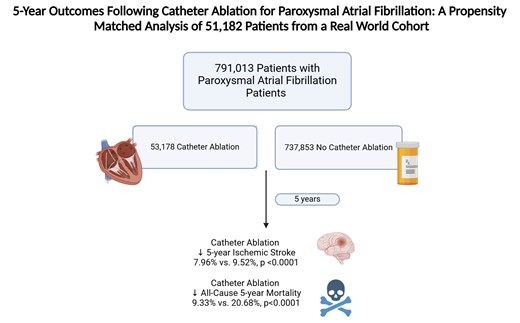-
Views
-
Cite
Cite
Ahmed Maraey, Dharmindra Dulal, Ahmed Elzanaty, Mahmoud Khalil, Hadeer Elsharnoby, Mohammad Alqadi, Omar Kahaly, Abhishek Maan, Paul Chacko, 5-Year Outcomes Following Catheter Ablation for Paroxysmal Atrial Fibrillation: A Propensity Matched Analysis of 51,182 Patients from a Real World Cohort, European Heart Journal - Quality of Care and Clinical Outcomes, 2025;, qcaf020, https://doi.org/10.1093/ehjqcco/qcaf020
Close - Share Icon Share
Abstract
Atrial fibrillation (AF) poses significant risks of stroke and mortality. Catheter ablation (CA) has emerged as a superior rhythm control strategy compared to medical therapy, but its long-term benefits in AF, in ischemic stroke prevention, remain underexplored.
This observational study analyzed data from the TriNetX Research Network, encompassing over 115 million patients. Adults diagnosed with paroxysmal atrial fibrillation (PAF) between 2012 and 2019 were stratified into CA and non-CA groups. Propensity score matching (PSM) accounted for baseline differences in demographics, comorbidities, and medication use. The primary outcome was ischemic stroke rates at five years, with and without prior ischemic stroke. Secondary outcomes included all-cause mortality. Kaplan-Meier survival analysis and Cox proportional hazards regression were used to estimate adjusted hazard ratios (HRs).
Among 791,013 patients with PAF, 53,178 (6.7%) underwent CA. Post-PSM, ischemic stroke rates were significantly lower in the CA group (7.96% vs. 9.52%, HR: 0.823, 95% CI: 0.785–0.863, p < 0.0001), even after excluding patients with prior ischemic stroke (de-novo ischemic stroke) (4.70% vs. 6.43% HR: 0.709, 95% CI: 0.665–0.756, p < 0.0001). All-cause mortality was markedly reduced (9.33% vs. 20.68% HR: 0.388, 95% CI: 0.373–0.404, p < 0.0001).
This large-scale study demonstrates that in PAF patients CA is associated with lower ischemic stroke rates and all-cause mortality compared to a PSM group without CA. These findings support urgent evaluation of CA in managing PAF and highlight its role in potentially improving survival and reducing stroke risk. Further trials are needed to support these findings.





